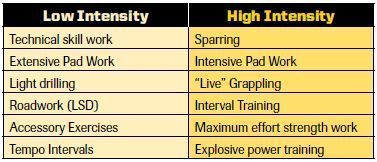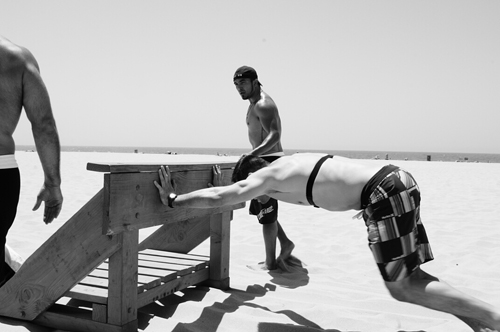
This is a reprint of my article in Fight! magazine, “The High Low Mix Up” and a discussion of how to use the High/Low model of programming for combat sports. This is the general model I use with all my fighters and in my experience and opinion, it’s hands down the best way to structure a fighter’s training week. Any fighter who isn’t using it, should be.
Reprinted with permission from Fight! Magazine
Given the often brutal and unforgiving nature of MMA, it’s not surprising that those who plan to step into the cage rarely lack the motivation that it takes to train hard. Undoubtedly, very few athletes in any sport train as frequently or with as much intensity as combat sport athletes.
There is no question that it takes a seemingly endless amount of work to master the variety of combat skills required to become a well-rounded fighter, and this daily training grind can take its toll on even the most mentally and physically determined. Sooner or later, in the face of such unrelenting daily punishment, the body gets worn down, beaten up, and overcome by chronic injuries. The fact that so few pros are able to stay on top of the sport for more than a year or two, before getting knocked out and beaten up by younger and healthier fighters, is evidence of just how difficult training for a sport like mixed martial arts can be.
Whether you’re a veteran of the sport trying to prolong your career or just training for fun and fitness, if you value your performance as well as your health, your goal should always be to maximize your skill development while minimizing the amount of stress and damage done to your body along the way. Anyone can go into the gym everyday out and train their guts out, but the real key to achieving your goals is to find a way to train smarter rather than harder.
Less Pain, More Gain
Get Better Results Without Working Harder
In a testosterone fueled sport that requires getting punched, kicked, kneed, and elbowed simply in the routine of training, it’s easy to see why so many fighters believe that there are generally only two ways
to get better— train harder or train more. In many cases, these two strategies are combined, and it’s not uncommon for a fighter using such an approach to be in the gym for three or more hours a day, up to five or six days a week.
While this mindset of intense work may seem like a good idea, more often than not it leads to more harm than good. Training that was once productive quickly becomes plagued by nagging injuries, and skills are dulled in a haze of accumulated fatigue as each week goes on. Instead of sharpening skills and becoming a better fighter, the real battle becomes trying to avoid feeling mentally and physically beaten up all the time.
This all too common scenario can be seen on the faces of countless fighters in gyms across the country. The good news is, there is a much better approach to training—one that doesn’t involve feeling like you’re killing yourself in the gym on a daily basis. Not only does this approach lead to better improvements in skill development, overall performance, and fitness levels, it also keeps you healthier
The High/Low Model
Don’t Get Stuck In the Middle
The reason many fighters don’t get as much out of their training as they could, despite training hard every day, is simple—they spend the majority of their training time “in the middle.” This means that even though they may feel like they are training as hard as they can, they actually aren’t training anywhere near 100%, because they are still fatigued from the previous day’s training.
Regardless of how tough you may think you are, your body wasn’t designed to operate at 100% for very long without needing time to rest and recover. If you don’t give it that time, your body begins to accumulate fatigue and is no longer able to perform at its highest levels. You can train as hard as you want, but your body simply isn’t going to be as fast and powerful or operate as well as when you are well-rested. There is no way around this hard biological fact.
Most professional sports have evolved training programs that take this factor into account. But many fighters still think they can go to the gym five days a week and hit pads, roll, spar five hard rounds and then strength train, without any problems. Generally, under this type of regiment, the first couple of training days are productive, while the rest of the week is typically ineffective. The body feels heavy, reaction rate slows down, and endurance suffers as you begin to feel the effects of accumulative fatigue.
This is the reason why injuries are more likely to happen later in the training week. The end result is that the majority of training ends up in the middle zone—neither light enough to allow for recovery, nor high enough to force adaptations in performance. Many refer to this no-man’s land as the training black hole.
A much better and more effective program can be achieved by organizing your training days with the “High/Low” system. The idea is to split training into days of high intensity and days of low intensity. The high days are done at the highest intensities possible, and the low days are light enough that they allow the body to fully recover.
Rather than spending at least half the training week in a fatigued state, you’re able to perform at 100% and get the most out of the high days. Low days can be spent learning new skills, sharpening your technique, and improving your aerobic fitness. A summary of the High/Low system applied to combat sports and appropriate training methods for each of the days can be seen in the table below.

Going Low
Sometimes Less is More
It may seem difficult at first for a fighter to finish a workout without feeling totally and utterly exhausted, but for the high-low system to work effectively, this is exactly what you have to do. This doesn’t mean you should feel like you didn’t get in any work at all. It simply means that at the end of the training session you shouldn’t feel like it takes every bit of energy you have left just to drive home. On an intensity scale of 1-10, with 10 being the most difficult training you’ve ever done and one being sitting on your couch watching television, a “low” training session should be at a six or below.
Your low days should be spent learning new skills and perfecting techniques, because when you are overly fatigued, your ability to do so diminishes rapidly. Think about a baseball player trying to perfect his swing. He wouldn’t swing the bat 100 times in a row as hard as he could and then expect that approach to lead to more consistent hitting. Instead, he’d take his time with each swing, analyze what he’s doing well and what technical mistakes he is making and then work to
correct them.
Many combat athletes fail to understand that this is the exact same approach that should be used to learn and perfect the many skills required to be a well-rounded fighter. Everything from shadow boxing to pad-work to standup or ground technique should be done regularly at lower intensities to ensure that the body’s nervous system learns how to perform the skills correctly.
The old phrase “practice makes perfect” should be replaced with “practice makes permanent.” The more you do something, the more your body begins to do it the same way each time. If you always learn and work on your skills in a constant state of fatigue—which far too many fighters do—you will build poor technical habits and make it more difficult to fix your problems later on.
Low Guidelines
- Focus on learning new skills and/or perfecting the technique of ones you already have
- Keep overall training intensity at 6 or below on a scale of 1-10
- Heart rate should be below anaerobic threshold for the majority of the training session(in the 160s-170s for most combat athletes)
- Avoid high CNS activities like sparring, heavy or explosive strength training, etc.
- Only perform accessory strength exercises in moderate repetitions, 8-15
Going High
Pushing it to your Limits
 High-intensity training days are how many fighters attempt to train every day. The difference is that in the High/Low system,these high intensity days will follow either a low day or a rest day, and thus, fatigue will be minimized while your performance is maximized.
High-intensity training days are how many fighters attempt to train every day. The difference is that in the High/Low system,these high intensity days will follow either a low day or a rest day, and thus, fatigue will be minimized while your performance is maximized.
These training sessions are where your hardest sparring, pad work, and rolling should take place, and the focus should be on working to your mental and physical limits. Because your next training day will be either a low day or an off day, you can give it everything you’ve got and go at a much harder pace than if you were planning to come back the next day with matched intensity.
If you are including heavy or explosive strength training in your program, you’ll want to include it on these high days. This is important because trying to do them on the low or rest days will impair your recovery and defeat the whole purpose of the High/Low system. Ideally, you should perform the strength and power exercises at a different time than your combat sports training, but if time is an issue they can be trained during the same session.
High Guidelines
- Focus on maximum intensity, training as hard as possible
- Heart rates during these sessions should exceed your anaerobic threshold and will often approach your maximum
- Include heavy and/or explosive training on these same day
- Most athletes can only sustain this type of work for a maximum of 2 hours
Putting it all Together
Organize your training week
Figuring out precisely how to organize the training week can be a difficult challenge for many fighters, because there are so many variables that need to be taken into account—from work schedules to family commitments to the availability of different coaches. To get the most out of your training, use the High/Low system as your framework.
The most important guideline is to always have at least one or two low days between high-intensity training sessions. Doing this will ensure that you’re able to get the most out of these intense sessions, because rather than being fatigued from the previous few days of training, you’ll be ready to go 100% and give it your all.
There are a variety of ways to organize your training days using the High/Low system. One of the most simple and effective ways to do so is presented below, but it can easily be reorganized depending on the limitations of your own schedule using the guidelines above. Regardless of how you choose to spread your high and low days throughout your training week, using the High/Low system is the smartest way to get the most out of all your hard training.



My question is can I do one or more exercises/technique for the Low day/High day or am I limited to only one drill?
i.e. Low day-Technical work & Tempo Intervals, High day-Sparing & Maximum effort strength work.
Thank you.